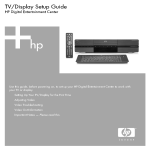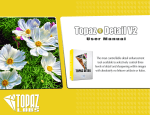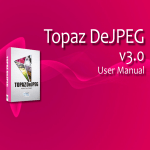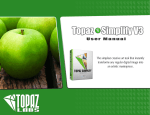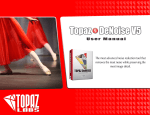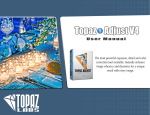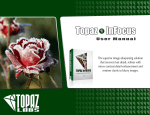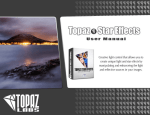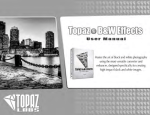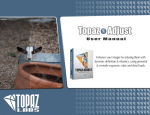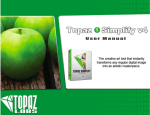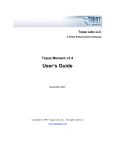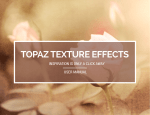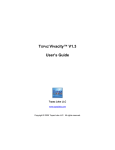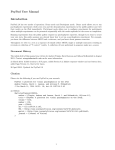Download User Manual - Topaz Labs
Transcript
Contents Topaz DeJPEG User Manual I. Installation A. How to Install B. Entering Your Key C. Host-Specific Installation 1. Paint Shop Pro 2. Photo Impact 3. Irfanview 3 3 3 4 5 6 II. Introduction A. JPEG Artifacts 1. What are JPEG Artifacts? 2. What Causes JPEG Artifacts? 3. Benefits & Consequences of JPEGs 4. JPEG tools vs. Noise Tools B. Topaz DeJPEG 1. About Topaz DeJPEG 2. Primary Functions of DeJPEG C. New DeJPEG Features 7 7 7 7 7 8 8 8 9 III. Work Area A. Interface B. Preview C. Presets 1. Applying Presets 2. Adding Presets 3. Deleting Presets 4. Importing Presets 5. Exporting Presets 6. Sharing Presets D. Tools E. Menu 1. Enter Key 2. What’s This? 3. User Guide 4. Tech Support 12 16 18 18 18 19 20 20 20 21 22 22 22 22 22 5. Product Info 6. DeJPEG Gallery 7. About 22 22 22 IV. Settings & Parameters A. Main 1. Reduce Artifacts 2. Smooth Color 3. Sharpen 4. Sharpen Radius B. Advanced 1. Luma Noise 2. Color Noise 3. Color Edge Radius 4. Edge Threshold 5. Saturation 6. Add Grain C. Preview Display Modes 1. Normal 2. Luminance 3. Color D. Auto-Brightness 23 23 23 24 24 24 24 24 24 24 24 24 24 24 24 24 24 VI. Work Flow A. Sample Project #1 B. Sample Project #2 25 33 VII. Additional Resources A. Glossary B. FAQ’s C. Shortcut Keys D. Connect E. Company Info 40 43 45 46 47 2 Installation Topaz DeJPEG User Manual Topaz DeJPEG is a Photoshop plug-in, which means it won’t run by itself and requires a compatible host program. To Install 1. Close Photoshop or other image editing program if you are using it. 2. Open the Topaz DeJPEG dmg or zip file, double-click on the Topaz DeJPEG installer, and then follow the onscreen instructions. Mac Dmg Windows Zip 3. Your Topaz plug-ins will automatically be installed in your Photoshop plug-ins folder. 4. After the installation, you will need to enter your license or trial key. Important for Mac Users: After installation, Topaz DeJPEG will be installed in the following folder: “ Macintosh HD -> Library -> Application Support -> Topaz Labs -> DeJPEG 4”. If your Photoshop is installed in a customized location, you will need to manually create a shortcut (alias) link inside folder “<Photoshop install folder> -> Plug-ins” that links to “ Macintosh HD -> Library -> Application Support -> Topaz Labs -> DeJPEG 4 -> Plug-ins”. Entering Your Key Entering your trial key allows you to save your projects and print them during your evaluation period. Entering your license key allows you do the same, except without any time limitations. 1. Start by opening up an image in Photoshop. 2. Go to Filters -> Topaz Labs -> DeJPEG 4 -> Menu -> Enter key. 3. You can then copy and paste or type your key in. Important: To install the product on a second computer, you will need to download Topaz DeJPEG and then enter your same license key. Host-Specific Installation Topaz DeJPEG is also compatible with Lightroom, Aperture and iPhoto. To use DeJPEG in any of these programs you will need to download and install the free Topaz Fusion Express compatibility add on. You can get it online at: www.topazlabs.com/downloads In Windows, Topaz DeJPEG is supported by most host applications that support Photoshop plug-ins. This includes Paint Shop Pro, Photo Impact, Painter, and Irfanview, although there are additional host programs that may also support Topaz DeJPEG. To install DeJPEG in either Paint Shop Pro, Photo Impact, or Irfranview first download Topaz DeJPEGto the default location. Then, to configure it into each program following the host-specific instructions on the next page. 3 Topaz DeJPEG User Manual How to install Topaz DeJPEG in Paintshop Pro 1. First launch PaintShop Pro. Installation 3. Choose C: \ Program Files \ Topaz Labs \ Topaz DeJPEG 4 plug-ins and click “OK”. 2. Go to Menu file -> Preferences -> File Locations. Select “Plug-ins” from the “File Types” list and click “Add”. 4 4. Topaz DeJPEG 4 is now available to use. Simply go to Effects -> Plug-ins and select “Topaz DeJPEG 4”. Topaz DeJPEG User Manual How to install Topaz DeJPEG in Photo Impact 1. First launch Photo Impact. 2. Go to File -> Preferences -> General or use shortcut key F6. Installation Then click on the button and browse to find the DeJPEG 4 plug-in folder located in: C: \ Program Files \ Topaz Labs \ Topaz DeJPEG 4 plug-ins and then click “OK”. 5 4. Restart Photo Impact. Go to Menu -> Effect to access plug-in. 3. Select Plug-ins from the Categories list. Topaz DeJPEG User Manual How to install Topaz DeJPEG in Irfanview 1. Make sure that you have downloaded and installed the 8bf plug-in add-on, available on the Irfanview webpage. (http://www.software.com/irfanview-plugin) Installation 3. In the screen that pops up, select “Add 8BF filters” and navigate to the C: \ Program Files \ Topaz Labs \ Topaz DeJPEG 4 \ Plug-ins folder and click “OK”. You will then see “Topaz DeJPEG 4” in the Available / Loadable 8BF Filters section. 6 2. Open Irfanview and go to Image -> Effects -> Adobe 8BF filters. 4. To use Topaz DeJPEG 4 in the future, simply go to Image -> Effects> Adobe 8BF filters again and select “Topaz DeJPEG 4”. Topaz DeJPEG User Manual Uninstalling To uninstall Topaz DeJPEG follow these instructions: 3. Select Programs, then Uninstall a Program. Mac 1. Quit Photoshop (or other editing program). 4. Select Topaz DeJPEG and click remove. 2. Navigate to the Topaz Labs support files and frames located at: Macintosh HD -> Library -> Application Support -> Topaz Labs. Windows 7* 1. Quit Photoshop (or other editing program). 3. Locate the Topaz DeJPEG file and move it to the trash. You will need to enter your system password to OK this change. 4. Navigate to your Photoshop plug-ins folder located at: Applications -> Photoshop -> Plug-ins 5. Locate any leftover Topaz DeJPEG files and move it to the trash. Windows XP* 1. Quit Photoshop (or other editing program). 2. Click on the Start Menu and select Control Panel. 3. Double-click on Add / Remove programs. 4. Select Topaz DeJPEG and click remove. Windows Vista* 1. Quit Photoshop (or other editing program). 2. Click on the Start Menu and select Control Panel. 2. Click on the Start Menu and select Control Panel -> Programs -> Programs and Features. 3. Select Topaz DeJPEG and click uninstall. *Please note that if you also have the 64-bit version of DeJPEG installed, then you will need to first uninstall this version before you can uninstall the regular version. 7 Topaz DeJPEG User Manual Introduction JPEG Artifacts What Are JPEG Compression Artifacts? JPEG compression artifacts are random and unwanted image distortions that appear in JPEG images. Most often, JPEG artifacts appear in photos as blocks, dots and fringes. These artifacts are also referred to as: Checkerboarding, and mosquito noise. To see if your images are being affected by JPEG artifacts because of compression, zoom in on the image and look for areas with checkerboard patterns, mosquito noise, fuzziness, reduced detail, reduced clarity or uneven color. What Causes JPEG Compression Artifacts? JPEG compression artifacts are caused by the compression that occurs when you save an image in the jpeg format. JPEG images can be saved at different levels of compression and quality. Using a higher compression produces a lower-quality image and a smaller image size. Using a lower compression produces a higherquality image and a larger file size. Benefits and Consequences of the JPEG Format Using the JPEG image format is popular because it reduces file sizes and allows for increased storage. Most web images are JPEGs for this very reason. However using the JPEG format also comes with unwanted and typically irreversible side effects. The JPEG format is a lossy form of compression, and as a result, image quality is lost and artifacts are introduced. Rhe quality that is lost from compression cannot be restored and 8 will continue to diminish in quality every time you edit and save the image in the JPEG format. Why can’t I use a Noise Reduction Program to Remove JPEG Compression Artifacts? Noise reduction algorithms are not effective at removing JPEG artifacts caused by lossy compression methods because images noise is not the same as compression artifacts. Programs specialized in JPEG artifact elimination can easily target artifacts, successfully remove them and drastically improve your image with precision. For more information and to see examples visit: www.topazlabs.com/dejpeg Introduction Topaz DeJPEG User Manual Topaz DeJPEG About Topaz DeJPEG Topaz DeJPEG is a Photoshop plug-in that uses a recent breakthrough in image processing technology to eliminate the problems caused by JPEG image compression. It is the optimal way to fix JPEG images and remove artifacts. With Topaz DeJPEG, you can recover and create highquality JPEG images, by eliminating the typical JPEG image distortions that degrade image quality. Topaz DeJPEG reduces lossy JPEG compression artifacts while recovering and retaining essential image detail, offering users unprecedented control over the clarity and quality of your JPEG Images. The Primary Functions of Topaz DeJPEG Include: 1. Remove JPEG compression artifacts such as checkerboarding and mosquito noise. 2. Intelligent color and line enhancement to clarify original image detail and preserve image integrity. 3. Fix fuziness and image blur caused by JPEG compression. 4. Sharpen color edges. 5. Smooth color unevenness. To connect with other Topaz users, participate in Topaz contests and to see the latest tips, tricks and tutorials sign up for the new Topaz Forum online at: www.topazlabs.com/forum 9 Topaz DeJPEG User Manual Introduction New DeJPEG Features Topaz DeJPEG 4.0 Features 1. Auto Updater. Get software updates instantly. 2. New user interface. 3. Snap / Recall buttons. Save up to 99 snapshot settings for comparison. 4. Undo / Redo buttons. 5. Collapsible side panels. Expand and collapse the preset panel and the tool panel for an adjustable workspace. 6. Collapsible tabs. Open and close the parameter tabs as you need them. Before Topaz DeJPEG 7. Preset Enable / Disable option. Option to enable or disable the preset preview processing at program startup. 8. Presets Layout. New preset format with single preset preview window. 9. Preset Navigation. Use the up / down arrow keys to navigate the preset list and display the selected preset thumbnail (in preset preview window). Use the return (Enter) key to apply the currently selected preset. 10. Enable / Disable Tool Tips. Option to enable or disable the pop up tool tips. 11. Quick Slider Reset. Double click on the slider name to reset default slider values. After Topaz DeJPEG 10 Introduction Topaz DeJPEG User Manual 11 Before Topaz DeJPEG Introduction Topaz DeJPEG User Manual 12 After Topaz DeJPEG Work Area Topaz DeJPEG User Manual Interface (Main View) Although the Topaz DeJPEG interface may look intimidating at first glance, don’t worry: it’s actually quite simple and easy to use. You’ll soon be a pro after experimenting with it for a bit. In order to make sense of the function of each of the various controls, we have divided the interface into a few sections: 1 4 3 5 2 1. Presets Preview 2. Presets Panel 3. Preview Window 4. Preview Navigator 5. Settings & Parameters The removable preview window displays preset previews. Provides “snapshots” of pre-defined effects. Displays the preview of the original and adjusted image. Displays the region of the preview image you are currently focused on. Controls the editing using sliders to adjust the various effects. 13 Topaz DeJPEG User Manual Work Area Interface (Tool Panel View) Use the small white arrows to expand and collapse the preset panel. You can click the white arrow edge of the panel and drag it in or out. or grab the 14 Topaz DeJPEG User Manual Work Area Interface (No Panel View) Use the small white arrows to expand and collapse the preset and tool panels. You can click the white arrows or grab the edge of the panels and drag them in or out. 15 Topaz DeJPEG User Manual Work Area Interface (Preset Panel View) Use the small white arrows to expand and collapse the tool panel. You can click the white arrow edge of the panel and drag it in or out. or grab the 16 Work Area Topaz DeJPEG User Manual Preview Section The Preview section is the main window that is centered in the DeJPEG interface. The preview section shows you the original image and the processed preview of the image. Click on the image in the preview window (or use the Original and Preview buttons) to switch between the Original and Preview tabs and compare the filtered and un-filtered images. To pan the preview image, click and hold the left mouse button on the preview image and drag it around. When you let go of the mouse button, the new portion of the image will be processed and the result will be displayed. You can also use SPACE bar or your numbered shortcut keys “1” and “2” to switch back and forth between your filtered and unfiltered image in the preview window. 1 17 Work Area Topaz DeJPEG User Manual 18 You can zoom in or out of the preview image by clicking the “+”, or “-” buttons below the preview image. You can also resize the window as well by dragging the bottom right corner in and out. Please note: The minimum that you can zoom out is 100%. Anything below 100% hinders your ability to identify and remove jpeg artifacts. The ideal zoom setting is 200% The “Ctrl +” and “Ctrl –” keys zoom in and out of the image, just like in Photoshop. You can use the arrow keys to adjust the value of the slider that is currently selected. A complete list of the shortcut keys can be found in the Shortcut Keys section later in this manual. Photoshop and other host software support many Image Modes, such as Grayscale, RGB, LAB, CMYK, etc. Images can also be 8, 16, or 32 bits per channel. Topaz DeJPEG supports both 8 bits per channel and 16 bits per channel. Topaz DeJPEG supports RGB mode only. To work on black-and-white images, first convert them to RGB mode. Work Area Topaz DeJPEG User Manual Presets 1 1. Presets Preview Presets are a great way to speed up and simplify the whole process of using Topaz DeJPEG. Presets are set previews with previously defined settings that you can recall and reapply at any time. We’ve included some default presets for you and, although they won’t work for every single photograph, they serve as excellent starting points for customized tweaking. The removable preview window displays preset previews. Click Hide / Show to expand or collapse the preset preview window at anytime during your workflow. 2 Applying Presets Applying a default preset is easy and intuitive. Simply clicking on a preset will change all the settings in Topaz DeJPEG to match those in the selected preset. 2. Presets List Lists all of the saved presets available for use. To get the exact results you want, you may still want to go through the tabs and tweak the parameters. Adding Presets Sometimes it’s convenient to be able to define presets and save your settings for later use. To do this, first adjust the Topaz DeJPEG parameters until you’re satisfied with the result. Then, click on “Save”. Remember that you can easily expand or collapse the presets panel by clicking on the small white arrow on the edge of the panel or by grabbing the panel edge and dragging it in or out. 3. Preset Options The preset options allow you to save your presets, delete presets (default presents cannot be deleted), import new presets and export your saved presets to share with your friends. 3 19 Topaz DeJPEG User Manual Work Area Then enter a preset name, select the type of image that it is good for and then enter a description and click “OK”. You can also select a second image category type that the preset is good for. Note that if the name you’ve entered is the same as a preset you’ve already defined then you will be asked if overwrite the previous one. Your preset will be automatically saved as a new file with a “.tpp” extension in the Topaz DeJPEG Presets menu and the preview is automatically generated. To apply it later, just click it like any other preset. Deleting Presets If you’d like to delete a preset the select the preset name and then click on Delete. Please Note: Default presents cannot be overridden or deleted. Once you delete a preset it or overwrite it when saving, then it cannot be retrieved. Saved presets are located in the Topaz DeJPEG “Presets” folder: C: \ Program Files \ Topaz Labs \ Topaz DeJPEG \ Presets unless you’ve opted to install Topaz DeJPEG into a different directory. Mac users have this folder at Macintosh HD / Library / ApplicationSupport /TopazLabs / DeJPEG / Presets. 20 Topaz DeJPEG User Manual Importing Presets To import a preset file, click the “Import” button. This will open up a “Browse” box to import a saved preset from your computer into Topaz DeJPEG. This is useful if you have downloaded a preset file that you’d like to use. Work Area Exporting Presets To export the preset file to a certain location, click “Export”. Name your preset and save it to your desktop or other specified location that you have reserved for saved presets. 21 You can then share this preset file with others who may then import it. Sharing Presets Feel free to share your saved presets by emailing them to your friends and having them put it into their Topaz DeJPEG Presets folder. Visit the Topaz Labs Blog which features the latest Photography, software and design information including tutorials, videos, and thoughts about both Topaz and non-Topaz topics. Work Area Topaz DeJPEG User Manual Tools 1 You will use the various tools in the tools panel during your workflow to make your image adjustments. 1. Preview Navigator - Displays the region of the preview image you are currently focused on. 2. Zoom Buttons - Use the zoom buttons to zoom in and out of your image. Or you can also set your image to fit the preview window or to view it at 100%. 2 3 3. Undo and Redo buttons 4. Snap and Recall buttons. Save up to 99 snapshot settings for comparison. 22 4 5. Sliders and Parameters - Controls the editing process using sliders to adjust the various effects. 5 6. Additional Slider Controls - Use the “Reset All” button to reset all of the sliders values back to zero. Have more questions about Topaz DeJPEG 4 or any of the other Topaz software programs? Check out the new Topaz Knowledge Base online at: www.topazlabs.com/support/kb 6 Topaz DeJPEG User Manual Menu Work Area Check for Update Checks for available Topaz DeJPEG’ updates. You can access Topaz DeJPEG’s menu by clicking on the “Menu…” button at the bottom of the interface. 23 Click the Show Details button to get find out what’s included in the update before you install. Preferences Select this to enable or disable the program tool tips or the Auto-Update feature. Topaz DeJPEG User Manual Enter Key Select this to enter your trial or purchased license key. Work Area MyTopaz Brings you to the Topaz community where you can connect and interact with other Topaz users. Here you can also participate in discussions and contests, and share your favorite Topaz images. Tutorials Brings you to the Topaz DeJPEG tutorials page where you can access a variety of helpful video and text tutorials. You can also submit tutorials that you created here as well. About Select this to see what version of DeJPEG you currently have. What’s This? Select this (or click F1) then click on a feature in the Simplify interface to learn more about it. Users Guide Select it to pull up this user guide. Tech Support Brings you to the Topaz Labs support page where you can request assistance from our support specialists, contact our customer service team, retrieve lost license keys, or browse through our Knowledge Base. Product Info Select this to go to the Topaz DeJPEG web page to learn more about the Topaz DeJPEG plug-in. 24 Settings & Parameters Topaz DeJPEG User Manual Parameters Topaz DeJPEG has two settings tabs and a total of 10 parameters plus 3 display modes to help you achieve optimal image results. Main The Exposure tab includes the basic and most essential artifact removal tools. These tools are the main ones that you will use, and they will resolve most of your jpeg artifact issues. 25 DeJPEG Usage Tips: For most users, “Reduce Artifacts” is the only feature you will need to use when editing images that have minor JPEG artifact issues. Be sure not to overuse the “Reduce Artifacts” slider or this may cause your image to lose edge sharpness. More advanced users, or images suffering from serious artifacts, may require additional use the of the sliders in the Advanced tab. Reduce Artifacts Removes the artifacts in your image. A higher value removes more JPEG artifacts but may also over-soften the image. A good rule of thumb is to start with a smaller value and slowly increase this parameter to strike the perfect balance artifact removal and edge integrity. Smooth Color Smooths out the color in the image. A higher value provides a smoother color, but you may loose detail if you set this value too high. Topaz DeJPEG User Manual Sharpen Sharpens the image’s edges in order to compensate for the image softening that occurs from the JPEG artifact removal process. This parameter works in conjunction with the Sharpen Radius Parameter. Sharpen Radius This changes the edge size of sharpening, which is measured in pixels. This value adjusts how large the edges to be sharpened are. Use a larger value for more blurred areas, and a smaller area for less blurred areas. Advanced The Advanced tab offers additional tools that can help create a well-balanced image. Settings & Parameters Luma Noise Reduces noise in the luminance (black-and-white) channel. Color Noise Reduces noise in the color channels. Color Edge Radius Increases the sharpness of the color edge. The parameter is ideal for recovering lost color detail. Edge Threshold Sets the threshold above which the color edge will be enhanced. Use it to change the strength of the edge definition. Saturation Increases saturation and evens out image color to compensate for color loss due to artifact reduction. Add Grain Adds monochrome grain to the image in order to make it look more nature. DeJPEG offers 3 different Color Viewing Modes that you can use to help with artifact removal and image enhancement while using Topaz DeJPEG. Enable the “Auto-Brightness” feature to brighten the image for better viewing of artifacts in dark areas. AutoBrightness is for previewing only, your image will not stay brightened once you process your adjustments. 26 Workflow Topaz DeJPEG User Manual Sample Project #1 In this section, we will walk you through a sample project, step-by-step, to help you become more familiar with the DeJPEG program focusing on using the default presets. We will be using this artifact-damaged image for our example. The goal for this image is to remove the artifacts that are distorting the image and enhance the edges and lines. In the following steps, we will show you how to achieve optimal results with your own photos, following this model. So, let’s get started. 1. Open an image file. 2. Create a duplicate layer of your image. Right-click on your image layer in your layers and select “Duplicate Layer”. You can also achieve this by selecting your image layer and dragging it down to the new layer icon. 27 Before Topaz Adjust After Topaz Adjust Topaz DeJPEG User Manual 3. To begin working on your image go to Filters -> Topaz Labs -> DeJPEG 4. 4. Once your image loads, use the zoom tools to zoom in on a specific part of your image. Then you can click on the preview and drag it around until you find an area that you like. Workflow We want to remove the checker-boarding artifacts that are distorting the image, and reestablish the character of the image. To achieve this we will be working with the presets for this example, but you can start any way you like. 28 Topaz DeJPEG User Manual Workflow Normal Mode (Auto-brightness disabled) By default your mode is set to Normal when editing in DeJPEG. For most images this mode is sufficient for removing artifacts. More advanced users however, may want to incorporate the use of all three modes for optimal precision in removing artifacts. The Auto-brightness feature is disabled here making the image darker and artifacts less visible. 29 Topaz DeJPEG User Manual Workflow Luminance Mode Changing the Preview Display Mode to Luminance (black-and-white channel) provides another helpful view for identifying jpeg artifacts within your image. 30 Topaz DeJPEG User Manual Workflow Color Mode Changing the Preview Display Mode to Color provides another helpful view for identifying jpeg artifacts within your image. 31 Topaz DeJPEG User Manual Workflow 5. If you want to choose a default preset, scroll through the panel on the left side of the screen. To select it, just click on it and the sliders will automatically adjust to the pre-defined settings and parameters. For this example we will be using the Very Noisy JPEG preset. 32 If you are satisfied with the preset adjustments then you can click “OK” to process your image and save it back to Photoshop. Since I am happy with the immediate results I will go ahead and click OK to save and process my changes. For this example, only the Very Noisy JPEG preset was used to correct recover this JPEG image. For more information on incorporating manual adjustments please see Sample Project #2 on page 33. Don’t forget that you can use the shortcut keys in Topaz DeJPEG 4 to speed up your workflow. Workflow Topaz DeJPEG User Manual 33 Before Topaz DeJPEG Workflow Topaz DeJPEG User Manual 34 After Topaz DeJPEG Workflow Topaz DeJPEG User Manual Sample Project #2 In this project, we will walk you through a second DeJPEG workflow to show you how to better achieve optimal and natural-looking image results using the sliders in the Advanced tab. We will be using this home photo for our example. You can see the difference in detail and color in the two images because the original is damaged from compression. In the following steps, we will show you how to achieve optimal results with your own photos, following this model. Let’s get started. 1. Open an image file. 2. Create a duplicate layer of your image. Right-click on your image layer in your layers and select “Duplicate Layer”. You can also achieve this by selecting your image layer and dragging it down to the new layer icon. 35 Before Topaz DeJPEG After Topaz DeJPEG Don’t forget that you can use the shortcut keys in Topaz DeJPEG 4 to speed up your workflow. Topaz DeJPEG User Manual 3. To begin working on your image go to Filters -> Topaz Labs -> DeJPEG 4 4. Once your image loads, use the zoom tools to zoom in on a specific part of your image. Then you can click on the preview and drag it around until you find an area that you like. We want to remove the color artifacts that are distorting the image, and reestablish the character of the Workflow image scene. To achieve this we will be working with the presets and sliders for this example, but you can start any way you like. 5. If you want to choose a default preset, scroll through the panel on the left side of the screen. To select it, just click on it and the sliders will automatically adjust to the pre-defined settings and parameters. For this example we will be using the Highly Compressed JPEG preset. 36 Workflow Topaz DeJPEG User Manual With a variety of presets you will often find that a single selection will give you optimal image results. Incorporating Manual Adjustments: If you are satisfied with the preset adjustments then you can click “OK” to process your image and save it back to Photoshop. Start in the Main tab. It is a good idea to begin here, starting with the Reduce Artifacts slider and then progress to the Sharp Radius slider in order to see the effects of your adjustments easily. If you would like to make some additional adjustments to your enhancement settings then you can do so by adjusting any of the sliders in the two tabs manually until you achieve your preferred image results. 1. You should already be in the “Normal” color mode. Switch to the “Luma” color mode. This is the blackand-white mode which enables you to see the image without color artifacts. 37 Topaz DeJPEG User Manual 2. In “Luma” mode, go to the “Reduce Artifacts”slider under the Main tab and adjust it to a level where you are satisfied. Since a higher value may soften the edges, it’s a good idea to start with a small value and slowly increase it. That way, you can be sure that you sufficiently remove artifacts while preserving edge integrity. Workflow 4. Switch to the “Color” mode. If you find that the color in your image is a little uneven, adjust the “Smooth Color” slider to clean these areas. The Main tab will generally be all you need to use when making adjustments. However if you feel your image needs additional work then continue on to the Advanced tab. 5. If you find that there is noise in your image, you can reduce it by using the “Luma Noise” and “Color Noise” sliders. First, switch back to “Luma” mode and apply the “Luma Noise” adjustment. Then, return to “Color” and apply the “Color Noise” adjustment until you are satisfied. This will help clear up a noisy image. 6. Now, still in “Color” mode, you can improve color edge detail, by going to “Clr Edge Radius” and raising the value of that slider. Use it along with “Edge Threshold” to set the strength of the edge definition. 3. Then move to “Sharpen.” If you find that you have lost some edge detail by reducing blockiness, you can move this slider up to recover it. Use it with “Sharpen Radius” to control edge harshness. Higher levels are good especially for blurred areas. Your image should now be free of JPEG artifacts. To modify any additional aspects of the image, proceed with the next steps. Need to reset your slider values? Simply double-click on the slider name above the slider control to instantly reset the slider value to 0. 7. Color can also sometimes be weakened in the artifact reduction process. You can fix this by going to “Saturation” and raising the value of this slider to recover some color and balance out the saturation in the image. 8. Finally, you can add in some grain to make the final image look a little bit more natural with the “Add Grain” slider. This is set at a default value of 0.05. The best way to get great-looking images is to experiment with the filter until you’re satisfied. Despite the number of sliders and settings, getting a great result is easier than you might think! 38 Workflow Topaz DeJPEG User Manual Before Topaz DeJPEG 39 9. Once you are happy with your preset selection and your manual adjustments you are ready to click OK and watch your image transform. Topaz DeJPEG 4 gives you luma noise and color noise tools which are specific to jpeg artifact removal. However, if you are looking for more extensive noise reduction good for any image, be sure to check out Topaz DeNoise. After Topaz DeJPEG Please visit the Topaz DeJPEG website at http://www. topazlabs.com/dejpeg for video tutorials, tips, and tricks! Workflow Topaz DeJPEG User Manual 40 Before Topaz DeJPEG Workflow Topaz DeJPEG User Manual 41 After Topaz DeJPEG Topaz DeJPEG User Manual Achromatic - Without color. Algorithm - Any bit of code or programming that defines a process. Artifact- Any undesired alteration in data introduced during its digital processing. Glossary made up of a specific primary color. In a typical digital photo, the primary colors of red, green and blue (from the RGB color model) create all the colors in that photo, which may be represented by three color channels, each of red, green or blue. Blur - Make or become unclear or less distinct. Color Noise – A type of digital noise in which color edges are blurred or the image is unevenly colored and filled with spots. Brightness - The degree to which a color sample appears to reflect light. Color Profile - defines the range of colors that can appear in a digital photo. Checkerboarding – A type of distortion that shows up as abnormally large pixel blocks in the image; tends to show up in areas with lots of information; usually only occurs with highly-compressed images. Compression - The process of encoding digital information using fewer bits. Chroma - Purity or intensity of color. The difference of a color against the brightness of another color that appears white under similar viewing conditions. Clean Color – A parameter that controls the amount of color noise to reduce. CMYK - Cyan, magenta, yellow, and black. A color model commonly used for 4-color printing by printers to define and mix all of the colors they are capable of outputting. Color - The human perceptual response to different wavelengths of light impinging on the photo receptors in the retina. Color channel - The visual component of a color digital image that represents all the pixels in that picture Compression Artifacts – Fuzziness or distortion in a compressed image or sequence of video images caused by lossy compression, i.e., into a JPEG format. Download - The process of transmitting or transferring data from one device to another. Edge Artifacts – The “ringing” artifacts or distortions found around image edges. Export - Outbound data transfer in a format that can be used by other programs. Grain –Lightly speckled noise that is used to apply a more natural look to an image. HDR (High Dynamic Range) - Allows a greater dynamic range of luminances between the lightest and darkest areas of an image than standard digital imaging techniques or photographic methods. This wider dynamic 42 Topaz DeJPEG User Manual range allows HDR images to more accurately represent the wide range of intensity levels found in real scenes, ranging from direct sunlight to faint starlight. Image - An array of pixels that make up a digital picture. Import - Inbound data transfer into a file or document. ISO - The amount of sensitivity of a digital camera sensor. A higher ISO enables faster shutter speeds and/ or better performance in low light, but is more susceptible to experiencing increased noise. Lossless Compression - A reversible way of reducing the size of data while preserving it. Lossy - Computing of or relating to data compression in which unnecessary information is discarded. Lossy Compression - An irreversible way of reducing the size of data by approximating it. Luma (Luminance) - The brightness in an image (the “black” and “white” or achromatic portion of the image). Luma represents the achromatic image without any color, while chroma components represent the color information. Noise - Visible effects of interference in an image from a digital camera. Often appearing as random colored dots sprinkled throughout the image or uneven coloration in what should be smoothly-colored areas. It is most likely to show up in the darker or shadowed areas of an image. Noise can be an undesirable effect Glossary that detracts from overall image quality or something you can choose to create artistically. Pan and Zoom - A useful function that allows users to magnify the captured image in the preview and then, by using the cursor, to move or pan around the image. Typically Pan and Zoom allows users to magnify the image 2x or 4x time. By magnifying the images and zeroing in on a specific section, you can see details not visible when the entire image is sized to fit the preview. Parameter - A numerical or other measurable factor forming one of a set that defines a system or sets the conditions of its operation. Photo-editing or Imaging software – Programs in which you can alter your photos and / or create digital images. Depending on the software, you can improve exposure, color and other attributes of your picture, paint on it, add type, apply special effects, remove noise, resize it, combine it with other pictures, prepare it for e-mail or posting on the web, output it to a printer, or do any number of other manipulations or edits. Plug-in - A computing feature with the ability to be added to a system to give extra features or functions. Preset - A pre-defined combination of parameters and settings that is saved into a folder within Topaz Detail 2. Topaz provides default presets. A preview of each preset can be seen in the preset preview window located at the top left hand side of the interface above the preset list. 43 Topaz DeJPEG User Manual Glossary Preview- Shows the processed preview of the image. RAW image - An image file format that contains untouched, “raw” pixel information straight from the digital camera’s sensor. It has yet to translate the information in each pixel into the full color information, so this format offers more control over how the final JPEG or TIFF image is generated. Reduce Blur - An de-blur function that uses deconvolution technology rather than simple sharpening techniques. Refine – Improve (something) by making small changes to make it more subtle and accurate. RGB - Red, Green, Blue. The color model that is used in digital cameras and by computer monitors. Sharpness - The clarity of detail in a photo. Smoothing - To make a surface more regular or consistent; free from perceptible projections, lumps, or indentations. 44 Topaz DeJPEG User Manual “I need a Topaz DeJPEG trial key.” Visit http://www.topazlabs.com/downloads for a trial key. Please check your Spam folder because your Spam filter sometimes filters out the automated email. If you need more time to evaluate, please e-mail us at www.topazlabs.com/support for an extended trial key. “I can’t find Topaz DeJPEG in the Photoshop Filters menu.” If you’re using Windows: 1. Go to C: \ Program Files \ Topaz Labs \ Topaz DeJPEG 4 \ Plugins. Right click the file “tldejpeg4.8bf” and click “Copy”. 2. Go to your Photoshop Plug-Ins folder, usually located at C: \ Program Files \ Adobe \ Adobe Photoshop CSx \ Plug-Ins. First, delete anything that is currently there that has to do with Topaz DeJPEG 4 This includes any folder that might be labeled “Topaz DeJPEG 4” or any tldejpeg4.8bf file. After doing that, right-click on any empty space and click “Paste”. 3. Quit and restart Photoshop and Topaz DeJPEG will appear in your Filters menu. If you’re using Mac: 1. Go to Macintosh HD / Library / Application Support / Topaz Labs /dejpeg4 / Plug-ins and right-click Topaz_DeJPEG4.plugin. Click “Copy”. 2. Go to Applications/Adobe Photoshop CSx / Plug-Ins (or wherever your Photoshop Plug-Ins folder is located). Delete any current reference to Topaz DeJPEG 4. Afterwards, right-click any Frequently Asked Questions empty spot and paste the Topaz_Dejpeg4.plugin file into the Photoshop Plug-Ins folder. 3. Quit and restart Photoshop and Topaz DeJPEG 4 will appear in your Filters menu. “Do you have any other DeJPEG tutorials?” Yes, please see pages 25 and 33 of this Topaz DeJPEG user guide, and also visit: http://www.topazlabs.com/ tutorials/dejpeg “I do not have Photoshop, will DeJPEG work with my Elements, Aperture, Lightroom, iPhoto Paint Shop Pro, Photo Impact or Irfanview?” Yes, you can use Topaz DeJPEG with any of the above host programs. However, to use DeJPEG in Aperture, Lightroom or iPhoto, you will need to download the free Topaz Fusion Express add-on. For more information please visit: www.topazlabs.com/fusion “What are the limitations of the trial version of your software?” The only limit on the trial versions of the Topaz plug-ins is time. The free trial versions are designed to enable you to experience the full functionality of our plug-ins for a 30-day trial period. After the trial period is up, you will only be able to use the Topaz software by purchasing it. You will then receive a license key to activate the plug-in, and the trial version will automatically become the full version with no time limitations. 45 Topaz DeJPEG User Manual “If I use the 30-day trial version will I need to uninstall the trial version before I upgrade to a full version?” No, the Topaz trial software is designed to be unlocked to become the full version simply by entering a license key. The full license key will be e-mailed to you immediately after you purchase the software. “Where do I enter my key?” To enter your key please open an image in Photoshop and go to Filter -> Topaz Labs -> DeJPEG 4 -> Menu -> Enter Key. You can then copy & paste or type in your license key and then select OK. “I had Topaz DeJPEG as a trial, then I purchased. How do I enter my new license key?” You can enter your new license key by opening up an image in Photoshop and go to Filter -> Topaz Labs -> DeJPEG 4 -> Menu -> Enter Key. Please remove the trial key and enter your new purchased license key, then select OK and you are all set. “My Topaz DeJPEG key doesn’t work!” There are a couple of reasons why Topaz DeJPEG might think your license key is invalid. First, make sure that your key is in the proper format. It’ll be in the format “xxxxxx-xxxxxx-xxxxxx-xxxxxxxxxxxx” and will be all numbers in 30 digits in five groups of six (no letters). Second, make sure that as you’re entering the key Frequently Asked Questions there is nothing in the space beforehand. This means clicking, pressing Ctrl-A, and hitting delete to make sure that absolutely nothing is in that field before you paste in the key. If it doesn’t work when you copy and paste, try typing it out, and vice versa. My Topaz filters are grayed out in the filter menu. Please make sure that you are using a 8-bit or 16-bit image that is in RGB color mode. Also, if your project includes adjustment layers please make sure that you are not on an adjustment layer. You will need to select the image layer. This will allow you to access your Topaz programs. I have a question not listed here. Please visit our knowledge base online at: http://www.topazlabs.com/support/kb/ If you are not able to find the answer there then contact our support specialists online at: www.topazlabs. com/support or e-mail customer support at: help@ topazlabs.com 46 Shortcut Keys Topaz DeJPEG User Manual Topaz DeJPEG uses some shortcut keys to speed up your workflow. Many of these keys are similar to those in Photoshop. The following keys work at all times. MAC Shortcut PC Shortcut Spacebar CMD-ALT-R Spacebar CTRL-ALT-R CMD-ALT-0 CTRL-ALT-0 Action + or CMD - + + or CTRL - + - or CMD - - - or CTRL - CMD -Z Ctrl - Z CMD - Shift - Z Ctrl - Shift - Z M A S CMD-Shift-P CTRL-Shift-P CMD-Shift-N CTRL-Shift-N CMD-1 CTRL-1 CMD-2 CTRL-2 Left or Right Arrow Key Return (enter) key [ key ] key Home Key End Key Double-click slider name View Original Image Reset All Zoom to 100% Zoom In Zoom Out Undo Redo Expands / Collapses Main Tab Expands / Collapses Advanced Tab Takes a Snapshot Recalls previous Snapshot Recalls next Snapshot View Original Image View Adjusted Image Scrolls through presets Applies selected preset Reduces selected slider value by 0.1 Increases selected slider value by 0.1 Set the slider value to minimum Set the slider value to maximum Resets the slider to it’s default value Mac and PC Shortcuts are the same unless indicated otherwise. 47 Topaz DeJPEG User Manual Connect with Topaz Check out our new Forum and our blog for tutorials, tips and updates from Topaz Labs! 48 Follow us on Twitter for notifications of recent news and easily get in touch with us whenever you feel like it! Find us on our Facebook page and network with other Topaz users! Participate in the entirely user-led Topaz Flickr group for a helpful and highly active community for Topaz Photoshop plug-ins! Subscribe to our YouTube channel to keep up with any newly released product video tutorials! Topaz DeJPEG User Manual Contact Information Topaz Labs LLC 5001 Spring Valley Road Suite 400 East Dallas, TX 75244 Technical Support Visit: http://topazlabs.com/support/ Email: [email protected] 49 Topaz Labs LLC, a privately owned company in Dallas, Texas, focuses on developing advanced video and image enhancement technology. With today’s widespread use of digital still cameras, digital video cameras, and HDTV, the need for highquality digital images and videos has greatly increased. Topaz Labs’ mission is to bring practical state-of-the-art image and video enhancement technology to both professionals and consumers. Copyright © 2009 Topaz Labs, LLC. All rights reserved. http://www.topazlabs.com Topaz DeJPEG User Manual Be sure to check out the complete line up of Topaz products. Image Plug-ins Advanced JPEG artifact reduction filters eliminate JPEG compression artifacts while preserving image detail like never before. 3 levels of intricate and specific detail enhancement for naturally enhanced images with no halos. Advanced noise reduction filters noise while maximizing and retaining image detail simply and effortlessly. Specializes in overall image improvement. Features sharpening, reconstructing, enlarging, high-quality noise removal and JPEG artifact damage tools. Remove unwanted backgrounds from your digital images quickly and easily with the new Topaz ReMask. Takes any of your regular photos and effortlessly turn them into beautiful works of art. Specializes in creating crisp and stylized images. Also features extensive smoothing capabilities. Ultimate control over image exposure, detail, and color gives you the power to make your photos pop. Bring the power of Topaz to your Aperture, iPhoto and Lightoom workflow with the new Fusion Express plug-in. Video Plug-ins Increase video quality with this suite of video enhancement filters utilizing super-resolution technology. Easily and efficiently capture video frames and significantly increase their quality and resolution with this standalone Windows application. Go to http://www.topazlabs.com/downloads to get your 30-day free trial! 50


















































